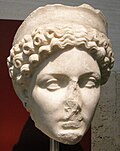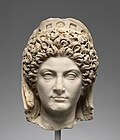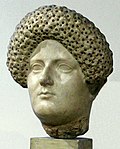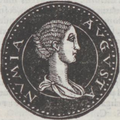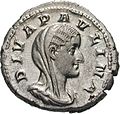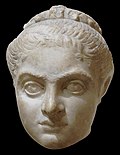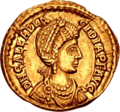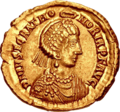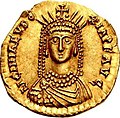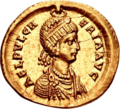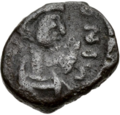Top Qs
Timeline
Chat
Perspective
List of Roman and Byzantine empresses
From Wikipedia, the free encyclopedia
Remove ads
The term Roman empress usually refers to the consorts of the Roman emperors, the rulers of the Roman Empire. The duties, power and influence of empresses varied depending on the time period, contemporary politics and the personalities of their husband and themselves. Empresses were typically highly regarded and respected, and many wielded great influence over imperial affairs. Several empresses served as regents on behalf of their husbands or sons and a handful ruled as empresses regnant, governing in their own right without a husband.

Given that there were sometimes more than one concurrent Roman emperor, there were also sometimes two or more concurrent Roman empresses. For most of the period from 286 to 480, the Roman Empire, though remaining a single polity, was administratively divided into the Western Roman Empire and the Eastern Roman Empire. Through most of this period, the separated imperial courts had their own lines of succession, and as a result their own sequences of concurrent Roman empresses. The western empire fell in the late 5th century, its final empress being the wife of Emperor Julius Nepos. The eastern empire, often referred to as the 'Byzantine Empire' by modern historians, endured for almost another millennium until its fall through the fall of Constantinople in 1453. The final empress of the east, and final Roman empress overall, was Maria of Trebizond, wife of Emperor John VIII Palaiologos.
Though the constitutional power of empresses was never defined, it was generally accepted that their coronation, performed after that of their husbands, granted them some imperial power. Often, their primary duties were to oversee the organization of ceremonies at the imperial court as well as to partake in imperial and religious affairs. Although governmental power was most often vested only in the emperor, empresses could gain significant authority as regents for young children or when their husbands were absent. Though they were bound by the wishes and temperaments of their husbands, empress consorts could at times also effectively become influential co-regents. In some cases, emperors reinforced their legitimacy through marrying the daughter of a previous emperor. In such cases, empresses sometimes stressed their dynastic legitimacy, greater than that of their husbands, to achieve great influence. Several influential consorts, such as Theodora, wife of Justinian I, and Euphrosyne, wife of Alexios III, held their own courts.[1]
Remove ads
Titles
Summarize
Perspective
There was no single official term for the position of "empress" in Ancient Rome.
Common titles
- The Latin title augusta (Greek: αὐγούστα, augoústa), the female form of augustus, was usually given to Roman consorts. Insofar as augustus is understood as meaning "emperor", then a given woman could not become "empress" until being named augusta.[2] However, not all consorts were given the title by their husbands. The title was sometimes given to other female members of the family, so empress and augusta are not always treated as synonyms. In the third century, empresses could also receive various honorific titles, such as māter castrōrum "mother of the castra" and māter patriae "mother of the fatherland".
- The Greek title basilissa (βασίλισσα), the female form of basileus, was a common title for Byzantine empresses. Empress regnant Irene sometimes adopted the male title basileus.[3]
- The title despoina (δέσποινα), the female form of despotes, was also a common title for empresses in the later eastern empire.[3]
Noncommon titles
- The title caesarissa (Greek: καισάρισσα, kaisarissa[4]), the female form of caesar, was used for Ino Anastasia,[5] etc. It was used by the consorts of emperors as caesar's wife until being named augusta.
- The Latin term imperatrix, the feminine form of imperator, was used for Pulcheria,[6] etc. It seems to have rarely been used for Roman empresses.
- The title autokratorissa (αυτοκρατόρισσα), the female form of autokrator, was used for Anna of Savoy,[7] etc. It was not a common title for Roman empresses. Empresses regnant Zoe and Theodora sometimes adopted the male title autokrator.[3]
- The title sebaste, the feminine form of sebastos, was used for Maria Skleraina, etc. It was the Greek translation of augusta and ranked as a quasi-empress.[8]
Remove ads
Principate (27 BC – AD 284)
Summarize
Perspective
Julio-Claudian dynasty (27 BC – AD 68)
– Empresses who were not consorts or monarchs
Year of the Four Emperors (69)
Flavian dynasty (81–96)
Nerva–Antonine dynasty (98–192)
All empresses of this period received the title augusta.
Year of the Five Emperors (193)
All empresses of this period received the title augusta.
Severan dynasty (193–227)
All empresses of this period were named augusta on or shortly after their marriage.
Crisis of the Third Century (235–285)
All empresses during this period received the title augusta, with the sole exception of Numerian's wife.
Remove ads
Dominate (284–476)
Summarize
Perspective
Tetrarchy (284–324)
Only Valeria received the title of augusta during the Tetrarchy, and only a few women did so in the Constantinian and Valentinianic dynasties.
Constantinian dynasty (306–363)
Valentinianic dynasty (364–383)
Theodosian dynasty (379–457)
All empress, with the exceptions of Galla, "Elen", and Thermantia, received the title augusta.
Puppet emperors (west, 467–475)
Remove ads
Later eastern empresses (457–1439)
Summarize
Perspective
During the later 'Byzantine' period, all empresses (unless noted) received the title augusta; whether it was still considered a formal title or just a synonym to "empress" is not known.
Leonid dynasty (457–515)
Justinian dynasty (east, 518–602)
Heraclian dynasty (610–695)
Twenty Years' Anarchy (695–717)
Isaurian dynasty (717–802)
Nikephorian dynasty (802–813)
Amorian dynasty (820–867)
Macedonian dynasty (867–1056)
Doukas dynasty (1059–1081)
Komnenos dynasty (1081–1185)
Angelos dynasty (1185–1204)
Laskaris dynasty (1205–1258; Nicaea)
- Note: Roman rule in Constantinople was interrupted with the capture of the city by the Fourth Crusade in 1204. Though the crusaders created a new line of Latin emperors in the city, modern historians recognize the line of emperors of the Laskaris dynasty, reigning in Empire of Nicaea, as the legitimate Roman emperors during this period as the Nicene Empire eventually retook Constantinople. For the other lines of empresses, see List of empresses of the Byzantine successor states.
Irene Laskarina is called augusta on her seal, but it is not known if the honorific was used by other empresses too.
Palaiologos dynasty (1259–1439)
The honorific augusta appears on the seals of Theodora, Yolande-Irene, Rita-Maria and Anna of Savoy,[211] as well as on a miniature depicting Helena Dragaš. Given that no seals or documents of other empresses have survived, it is not known if all of them used the title, although it's most likely they did.
Remove ads
See also
Notes
- When no contemporary depictions exist, portraits are taken from the 16th-century Speculum Romanae Magnificentiae by Antonio Lafreri (1512–1577), who included a collection of empresses from Julius Caesar to Charles V, Holy Roman Emperor. Needless to say, these portraits are purely imaginary.
- Her full name is disputed; Suetonius calls her "Livia Orestilla", but Cassius Dio and later historians call her "Cornelia Orestina". See Kajava 1984.
- Suetonius states that Caligula divorced Paulina "in a short time". Dio explains that Caesonia was Caligulas' mistress and that she got pregnant during this time. Suetonius writes that Caesonia married on the same day she gave birth, while Dio states that she married one month before giving birth.[11][12]
- The Feriale Duranum records the birthday of "Faustina wife of Antoninus" as 20/22 September. However, it's not possible to determine if this refers to Faustina I, wife of Titus Aelius Antoninus Pius, or Faustina II, wife of Marcus Aurelius Antoninus[26]
- Empresses during the Tetrarchy often adopted their husband's nomen after their marriage. Diocletian's daughter Valeria thus became "Galeria Valeria" upon her marriage to Galerius.
- Kienast, Eck & Heil, p. 317, give her name as "Albia (?) Dominica", but does not elaborate. This name is not mentioned by the PLRE or other sources.
- Empress after Aelia Flaccilla adopted "Aelia" as a title, which was then shown in their coinage.[89]
- Flaccilla is called "Flavia" in a few inscriptions. She probably adopted the name following the accession of her husband, who also used "Flavius" as part of his nomenclature. Emperors after the Constantinian dynasty were often addressed as "Flavius", but it was used as an honorific rather than a personal name.[90]
- Julius Nepos continued to claim the imperial title in exile until May 480. He was apparently recognized by Emperor Zeno, but held no real power.
- Constantine III was crowned co-emperor in 613.
- Empresses were proclaimed augusta at their coronation.
- Constantine V was crowned co-emperor in 720.
- Romanos II was crowned co-emperor in 945.
- She stopped being empress for 6 months in 963, between the death of Romanos II (15 March) and her marriage to Nikephoros II (20 September).
- Romanos II was crowned co-emperor in 945.
- Constantine VIII was crowned co-emperor in 962.
- Some historians regard Eudokia as an empress regnant, while others consider her as a regent.
- Michael VII was crowned co-emperor in 1060.
- Alexios Komnenos was crowned co-emperor in 1119.
- She stopped being empress for a few months in 1183.
- Theodore II was proclaimed co-emperor in 1235, but was never crowned.
- Some Palaiologan empresses displayed over-complicated surnames, probably as an imitation of their husband's (although theirs were justified by their long ancestry, see Family tree of Byzantine emperors). The full surname of the Palaiologan emperors was "Doukas Angelos Komnenos Palaiologos".
- Andronikos II was crowned co-emperor on 8 November 1272.
- During the last years of the Empire, the territory of Thessalonica was effectively ruled as separate realm from Constantinople. Two empresses, Irene and Anna, took residence there, even having their own courts and ruling as de facto empresses regnant. Anna notably ruled in Thessalonica in opposition to John VI Kantakouzenos, who later recognized her portion of the empire.[217][218]
- Andronikos III was proclaimed co-emperor around 1310, but not crowned until 1325.
- A total reign of 39 years a few weeks; just some months behind Empress Ariadne.
- A total reign of 25 years and about 10 months.
- Andronikos IV was proclaiemd co-emperor in 1352.
- John VII was proclaimed co-emperor in 1377. He deposed his father in 1390, but was quickly defeated. He was released and ruled as regent during Manuel's absence (1399–1403), although it's not clear whether he ruled as "emperor". He was expelled from Constantinople as soon as Manuel returned, but was appointed "Emperor of Thessalonica" soon after.
Remove ads
References
External links
Wikiwand - on
Seamless Wikipedia browsing. On steroids.
Remove ads









